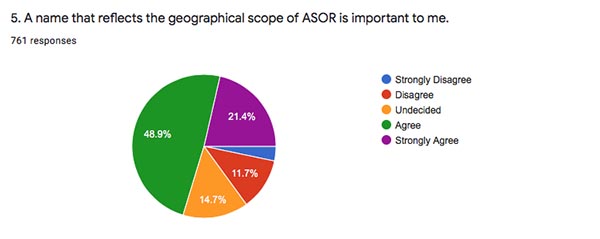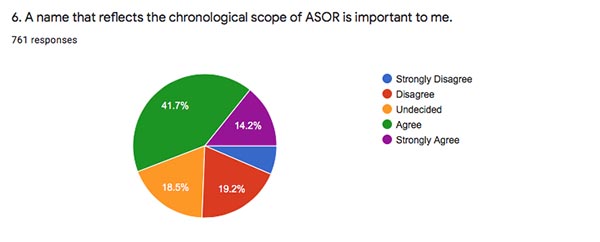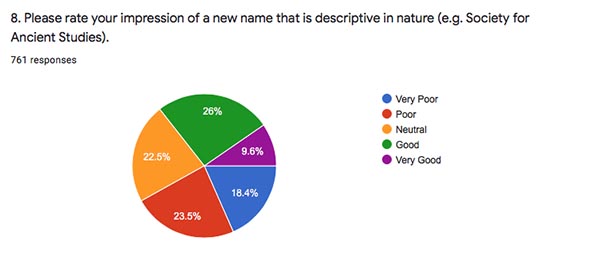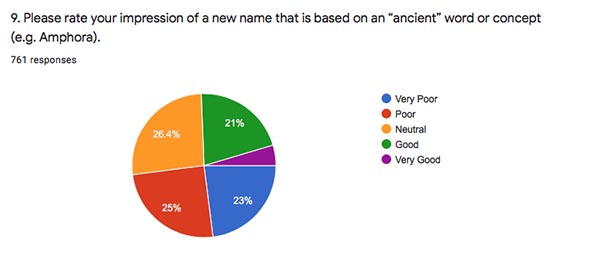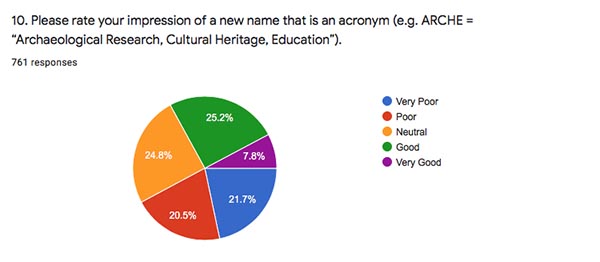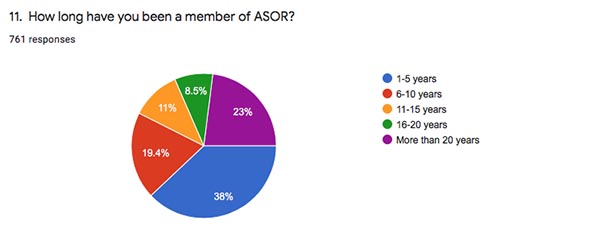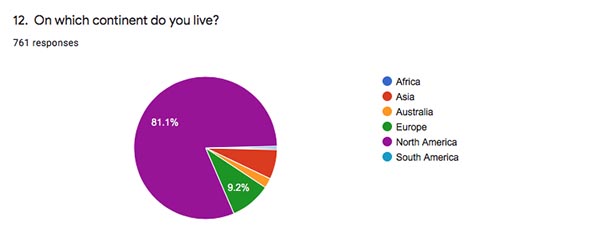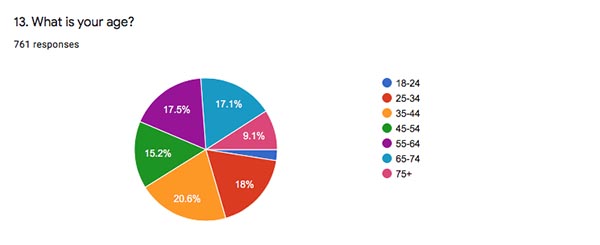
AD HOC COMMITTEE ON ASOR’S NAME: INTERIM REPORT
Background
The Ad Hoc Committee on ASOR’s Name was appointed by outgoing President Susan Ackerman and incoming President Sharon Herbert at the beginning of January, 2020. Its members include Trustees Randy Helm (chair), Emily Bonney, Lisa Ackerman, and Eric Welch, and members Eric Cline, Emily Hammer, and Kiersten Neumann. The charge to the committee is included as Attachment 1.
Process
Shortly after its membership was confirmed, Chair Helm distributed to the committee study documents relevant to past discussions of ASOR’s name. A list of these documents is included as Attachment 2.
The Committee met four times by Zoom between January 21 and April 22, 2020. After reviewing the materials and discussing the issues, we agreed on a work plan that would (a) assess the possible impact of a name change on the ability to access ASOR publications in the future; and (b) develop a survey that would provide a sense of ASOR members’ views on this question. The subcommittee on publications quickly determined that any impact of a name change on access to publications would be negligible. The survey subcommittee developed an instrument for the committee’s review.
With the assistance of ASOR staff, the survey was made available online to all ASOR members from March 18 – March 28. We received a very healthy response rate of approximately 30 percent. Comparing the demographics of survey respondents to the actual demographics of ASOR’s membership, we noted an overrepresentation of members who have belonged to ASOR for ten or more years (42.6% of respondents v. 29.7% of members). While we agreed that this was worth noting, we also agreed that the robust response made the survey results a reliable guide to members’ views on the issue of the organization’s name.
Survey Results (Attachment 3)
Demographics
Survey Respondents skew younger: 56.3% are younger than 55; 43.7% are older than 54. However, we don’t have age data for all ASOR members, so we don’t know if this is representative.
Areas of Consensus
- 70.3% agree or strongly agree that it is important that the society’s name reflects the geographical scope of ASOR’s work. Only 15% disagree or strongly disagree.
- 55.9% of respondents agree or strongly agree that it is important that the name reflects the chronological scope of ASOR’s work. Only 25.6% disagree or strongly disagree that this is important.
N.B. The current name does not communicate either the geographical or chronological scope of ASOR’s work.
Areas of Disagreement
- Keep the name “American Schools of Oriental Research?
- 45.3% agree or strongly agree
- 40.9% disagree or strongly disagree
- 13.8% undecided
- Eliminate the name, but keep the acronym ASOR?
- Approximately half of respondents (50.1%) disagree or strongly disagree
- A minority (32.2%) agree or strongly agree.
- Undecided = 17.7% (somewhat more than are undecided about keeping the historical name).
- Create a new name retrofitted to the ASOR acronym?
- 41.6% disagree or strongly disagree;
- 34.2% agree or strongly agree;
Observation: Enthusiasm for a retrofitted name is a popular option for members under 35 years old, but drops off sharply among respondents older than 35 and members for more than ten years.
- Create an entirely new name that is descriptive in nature (e.g. “Society for Ancient Studies”)?
- 41.9% have a poor or very poor impression;
- 35.6% have a good or very good impression.
- 22.5% are neutral.
Observation: No age group had a majority approving this option; support dropped off sharply among members of more than 10 years
- Create an entirely new name based on an ancient word or concept (e.g. “Amphora”)?
- 48% have a poor or very poor impression;
- 25.6% have a good or very good impression;
- 26.4% are neutral.
Observation: This would seem to be the least popular option. No age group had a majority approving this option; support dropped off sharply among members of more than 10 years.
- Create a new name that is a new acronym (e.g. “Archaeological Research and Cultural Heritage Education” – ARCHE)?
- 42.2% have a poor or very poor impression;
- 33% have a good or very good impression;
- 24.8% are neutral.
Viable Options
The Committee discussed these results in some detail, noting that older respondents favor retaining the full name and younger respondents favor a change. We acknowledged that the younger respondents represent the future of the organization, while the older respondents represent a group with deep loyalty to and knowledge of the organization.
We also discussed the difficulties that the current name and acronym create for younger scholars in terms of the publication and service records in their tenure and promotion dossiers. Neither the full name nor the acronym explains the organization’s purpose or work. Dossier readers outside the field are unlikely to understand the organization’s relevance or importance.
While the option of a new descriptive name that yields an acronym failed to find majority support among any age group, almost half of the younger members liked it, with stronger disapproval showing up as the age of members increased. We considered the possibility that this option could address the consensus on geographical and chronological descriptors in the name, and make it easier to explain to dossier-readers, younger scholars, and others.
We also noted that keeping the acronym ASOR as the only name of the organization might, even with a descriptive tagline, result in increasing confusion about the name’s meaning and the organization’s purpose over the passage of time. Some committee members felt that this would result in another committee needing to consider the name issue a few years down the road.
ASOR Board Discussion
Committee Member Trustees Ackerman, Bonney, Helm, and Welch provided the ASOR Board with an interim report at its May 14th meeting. While no straw polls were requested or taken, Board members generally agreed that the most productive option would seem to be to come up with a new name that is descriptive of our work and creates an acronym (either a new one, or one that comes close to the present one).
Next Steps
The Committee agreed that this is a suitable moment to seek the membership’s reaction to the survey results and the proposed course of action. Our preliminary assessment of possible names/acronyms yielded the following top five choices:
- Society for Archaeology, Philology, and History of the Middle East (SAPHME)
- Association for Archaeological Research and Cultural Heritage Education (AARCHE)
- Society for Ancient Near Eastern Research (SANER)
- Association for Archaeology, Research, Cultural Heritage, and Education (AARCHE)
- Society for Archaeology, Philology, and History of the Ancient Near East (SAPHANE)
Two options inspired enthusiastic responses but few votes and received honorable mention as “beautiful losers:”
International Society for Ancient Near Eastern Research (INSANER)
Society for Middle Eastern Research and Social History (SMERSH)
Your Ideas?
We now solicit feedback on the above listed possibilities, as well as new suggestions from all members for a name/acronym that describes our organization’s geographical, chronological, and methodological scope.
Click here to vote for your preferred name or offer your own suggestions up until July 15, 2020.
Because of the uncertainty of the format of the Fall meeting and the fullness of its schedule (if it happens), the Ad Hoc Committee agrees that this interim report – and our request for feedback – will eliminate the need for an open forum in November. Our hope is to process feedback and suggestions, and suggest naming options to the ASOR Board of Trustees in November.
Attachment 1: Charge to the Committee
We write, as the outgoing and incoming ASOR Presidents, to ask you to serve on an ad hoc committee charged with evaluating the name of our organization. ASOR Trustee Randy Helm has agreed to chair this committee and has agreed that he would very much like you to serve on this group. We hope you will accept. You are being invited because you have been active in ASOR and, we believe, because you have an open mind on this question. If you feel that you do not meet this last criterion, please let us know. We anticipate that there will be a wide diversity of strongly held opinions on this issue, and it will be important for the Committee to have credibility as a thoughtful and objective group who will be open to the ideas and arguments of others.
Background
ASOR members have been discussing the possibility of changing the organization’s name since at least 1982. Most recently, a workshop was offered at the 2018 ASOR Annual Meeting in Denver on “What’s in a Name? Re-assessing the Oriental in the American Schools of Oriental Research.” The workshop was very well attended, and the presentations and discussion were both thoughtful and provocative. As a result, the organizers created a summary of the workshop’s conversations and forwarded them to various governing bodies within ASOR, including the ASOR Board of Trustees. That summary was delivered in Fall 2019.
After considering this summary, the ASOR Board voted, at its November 2019 meeting, to continue the discussion by forming an ad hoc committee to study ASOR’s name.
Charge
The committee’s charge is to consider whether ASOR’s name is still appropriate for the organization and, if not, to recommend to the Board of Trustees a new name, or a modified name, or some selection of new or modified names that ASOR might adopt instead. Any decision to change or modify ASOR’s name would ultimately be made by the Board.
While this charge is succinctly stated, we do not mean to suggest it is easily undertaken. At a minimum, we envision that the committee will need (1) to review previous discussions about ASOR’s name; (2) review discussions other “O” organizations have had about their names and the decisions they have made, for example, the Oriental Institute at the University of Chicago and the School of Oriental and African Studies at the University of London; (3) review the experiences of other learned societies that have changed their names or have decided not to, including these learned societies’ discussions regarding the names of their publications; and (4) actively solicit and carefully consider input from the ASOR membership about ASOR’s current name and any possible name change.
We anticipate that the committee’s work should take between twelve to fifteen months, depending on how the committee chooses to go about its work, and especially its work of collecting feedback from the ASOR membership. The committee should thus plan on submitting its final report to the ASOR Board, with recommendations, no later than the April 2021 Board meeting. We look forward to supporting the committee in every way that we can, and we have already provided Randy with multiple documents to help in the committee’s deliberations and its decision-making process.
We hope that you will be able to serve on the important committee. Many thanks for considering this invitation, and we look forward to hearing from you.
Sincerely,
Susan Ackerman
ASOR President
Sharon Herbert
ASOR Vice President and President-Elect
Chair, Chairs Coordinating Council
Attachment 2: Study Documents reviewed by Committee Members
C&G Partners, Discovery Findings and Recommendations for ASOR Branding and Website Redesign, March 22, 2016
Orientalism Session – Raw Data 2018
Melissa Bailey Kutner, “Getting Oriented” 2018
Ian W. N. Jones, “’Isn’t that a Little Racist, Dr. Jones,’ or What I learned Trying tro Explain ASOR to High School Students” 2018
Danielle Steen Fatkin, “Orientalism in America: East Asia, West Asia, and the American Racial Imagination” 2018
Danielle Steen Fatkin, “Report to the CCC regarding the workshop ‘What’s in a Name? Re-assessing the Oriental in the American Schools of Oriental Research’ at the November 2018 Annual Meeting”
Michael M. Homan, “Why the Term ‘Oriental’ in ASOR is Neither Accurate Nor Appropriate.” 2018.
Straw Poll on ASOR Name Change, ASOR BoT 1982
Informal “Straw Ballot”, ASOR BoT 1982
Attachment 3: Survey Responses
1. Overall results (pie charts)
Strongly disagree: 133 17.5%
Disagree: 178 23.4%
Undecided: 105 13.8%
Agree: 176 23.1%
Strongly agree: 169 22.2%
Strongly disagree: 162 21.3%
Disagree: 219 28.8%
Undecided: 135 17.7%
Agree: 190 25%
Strongly agree: 55 7.2%
Strongly disagree: 167 21.9%
Disagree: 150 19.7%
Undecided: 137 18%
Agree: 213 28%
Strongly agree: 94 12.4%
Strongly disagree: 246 32.3%
Disagree: 146 19.2%
Undecided: 109 14.3%
Agree: 180 23.7%
Strongly agree: 80 10.5%
Strongly disagree: 25 3.3%
Disagree: 89 11.7%
Undecided: 112 14.7%
Agree: 372 48.9%
Strongly agree: 163 21.4%
Strongly disagree: 49 6.4%
Disagree: 146 19.2%
Undecided: 141 18.5%
Agree: 317 41.7%
Strongly agree: 108 14.2%
Very poor: 201 26.4%
Poor: 177 23.3%
Neutral: 152 20%
Good: 160 21.1%
Very good: 70 9.2%
Very poor: 140 18.4%
Poor: 179 23.5%
Neutral: 171 22.5%
Good: 198 26%
Very good: 73 9.6%
Very poor: 175 23%
Poor: 190 25%
Neutral: 201 26.4%
Good: 160 21%
Very good: 35 4.6%
Very poor: 165 21.7%
Poor: 156 20.5%
Neutral: 189 24.8%
Good: 192 25.2%
Very good: 59 7.8%
1-5 years: 289 38%
6-10 years: 148 19.4%
11-15 years: 84 11%
16-20 years: 65 8.5%
>20 years: 175 23%
Africa: 3 0.4%
Asia: 51 6.7%
Australia: 17 2.2%
Europe: 70 9.2%
N. America: 617 81.1%
S. America: 3 0.4%
18-24: 19 2.5%
25-34: 137 18%
35-44: 157 20.6%
45-54: 116 15.2%
55-64: 133 17.5%
65-74: 130 17.1%
75+: 69 9.1%




